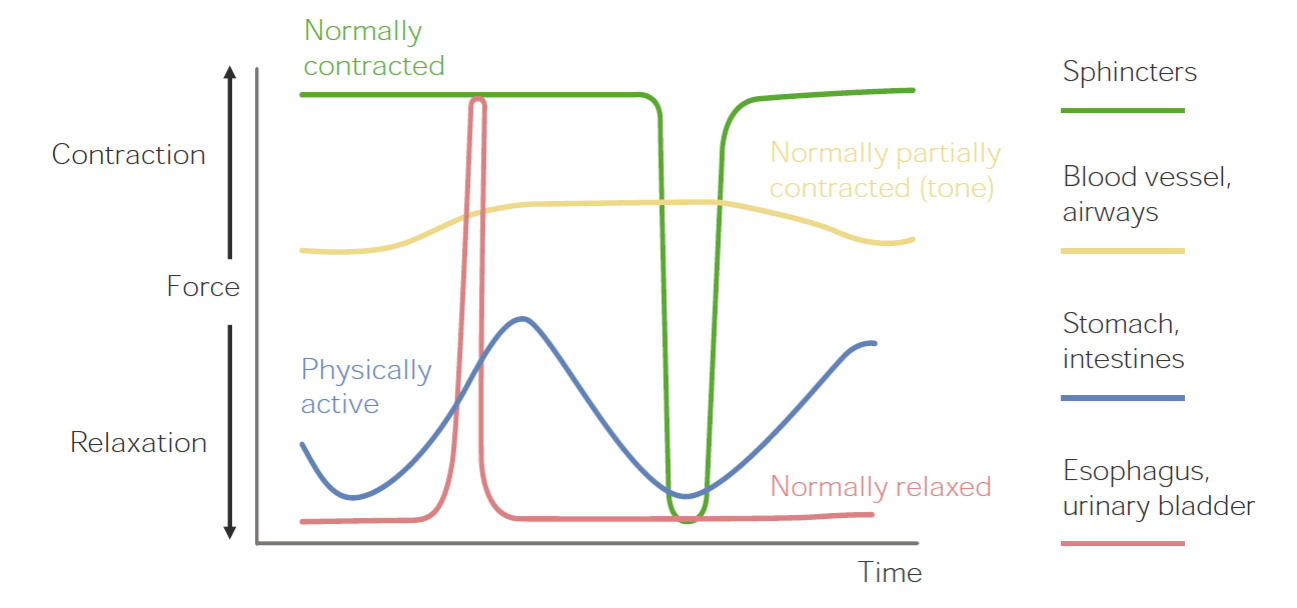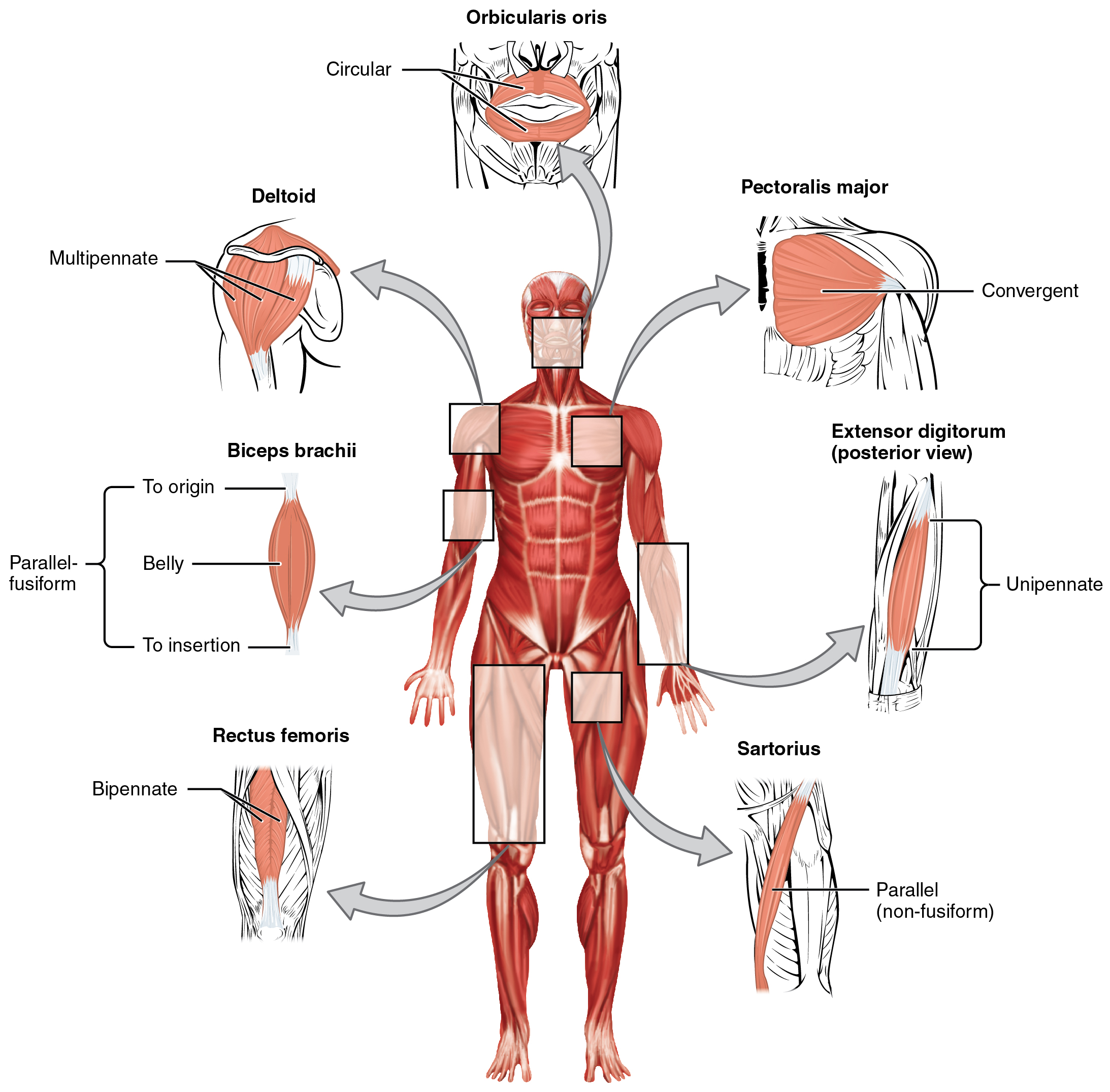Playlist
Show Playlist
Hide Playlist
Smooth Muscles: Contraction and Relaxation
-
Slides 03 SmoothMuscle MusculoskeletalSystem.pdf
-
Download Lecture Overview
00:01 So let’s go through the full process of how calcium causes the muscle to contract. 00:09 And to give you a little compare and contrast, we’ll use skeletal muscle as our contrasting agent. 00:16 So you start off with calcium, you end up with a contraction. 00:20 So let’s go through this process. 00:23 Smooth muscle, calcium binds to calmodulin, which then activates myosin light chain kinase, which phosphorylates myosin, which then causes actin-myosin interaction, crossbridge cycling, and contraction. 00:38 In skeletal muscle, calcium binds to troponin, which moves tropomyosin off the active site on actin. 00:47 Once actin is available, myosin-actin interactions occur, crossbridge cycling happens, and you get a contraction. 00:55 So those are the overall pathways between striated muscle contraction and smooth muscle contraction. 01:02 Now, let’s break each one of these parts down. 01:08 So, once we have calcium available, if we are in smooth muscle, we’re binding to calmodulin. 01:16 In skeletal muscle, striated muscle, we’re using troponin. 01:21 So both of these are the calcium-binding proteins, but they are different depending upon which tissue we’re talking about. 01:31 Their activation also activates a different molecule. 01:35 In terms of striated muscle, troponin moves tropomyosin off of an active site. 01:41 In terms of smooth muscle, calmodulin activates myosin light chain kinase. 01:47 The interesting thing about these two differences is myosin light chain kinase is known as thick filament regulation, while the movement of troponin is thin filament regulation. 01:59 So what is the think filament? That’s myosin. 02:02 What’s the thin filament? Actin. 02:07 In terms of smooth muscle, you get myosin light chain kinase to phosphorylate something, and in terms of skeletal muscle, you get tropomyosin to move off of a binding site. 02:19 So now let’s talk about the actin-myosin interactions. 02:23 So myosin is what is being regulated on smooth muscle, actin is what’s being regulated in skeletal muscle. 02:30 Both of these allow for the same kind of contraction process. 02:35 You need to have an interaction between actin and myosin no matter if you go from the myosin point of view or the actin point of view. 02:42 This will then lead to crossbridge cycling, which is what causes a muscle contraction to occur. 02:48 So some of the parts between skeletal muscle and smooth muscle are similar, but how you get to the activation portion is what is different. 02:58 The nice thing about using the smooth muscle contraction mechanism is not only is it gradiated, meaning that you can have large amounts of forces or small, but also it is a less vigorous and less rapid type of contraction. 03:15 Striated muscle or skeletal muscle usually is relatively fast and can have a high rate of force. 03:22 Okay. 03:23 So let’s now talk about crossbridge cycling in smooth muscle specifically. 03:29 You have light chains on myosin. 03:33 You have a binding site for inorganic phosphate. 03:36 You have a binding site for ADP. 03:40 Once you have calcium binding to calmodulin, it activates myosin light chain kinase. 03:48 If you activate myosin light chain kinase, you will get crossbridge cycling to want to start to occur. 03:56 Then you get binding of the myosin head to the active site on actin. 04:02 You lose the inorganic phosphate and the ADP. 04:09 ATP then binds here. 04:12 And finally, you’ve gone through the whole cycle. 04:15 But that binding, small movement, unbinding, binding, small movement, unbinding is characteristic of crossbridge cycling. 04:27 Now, what regulates crossbridge cycling? There are two primary enzymes. 04:32 So far, we’ve only talked about myosin light chain kinase and that’s denoted here. 04:38 But there’s another enzyme that we need to make sure that we’re aware of, and that’s myosin phosphatase. 04:44 So myosin phosphatase’s role is to inhibit myosin, while myosin light chain kinase is to activate it. 04:53 Okay. So let’s go through a couple of examples of how we can use one or the other enzyme to facilitate muscle contraction. 05:02 So, myosin light chain kinase, the normal activator of myosin, it will activate myosin to undergo contraction. 05:10 Myosin phosphatase inhibits myosin. 05:14 Now a number of processes affect myosin phosphatase. 05:20 Protein kinase C is a phosphatase inhibitor. 05:24 Also, rho kinase is a phosphatase inhibitor. 05:28 So this is where it gets a little complex. 05:31 So protein kinase C and rho kinase both inhibit myosin phosphatase. 05:39 If you inhibit an inhibitor, you activate it. 05:43 So, you can just think about the two inhibitors kind of cross-canceling each other out. 05:48 So you inhibit an inhibitor, you stimulate muscle contraction, and that can be seen here. 05:56 The other portion of regulating smooth muscle contraction is the formation of a latch-bridge state. 06:04 So oftentimes what a latch-bridge is, is to let myosin still be connected to actin, but not allowing it to fully relax. 06:15 This creates a little bit of tension in the muscle, but doesn’t start crossbridge cycling. 06:22 So if you think about this, why in the world would you want to cause a latch-bridge state? Hopefully, what came to mind is, well, is there a time where you wanted to maintain tonic contraction, but not spend a lot of energy? You can maybe cause a little contraction and kind of lock it there and that will maintain tension for a longer period of time without continually using ATP or energy to do that particular process. 06:51 There are many times that that’s important. 06:53 One of which could be something like a sphincter. 06:57 If you want to have a sphincter contracted for a long period of time, would you always want to tell it, “Contract, contract, contract, contract,” or would you simple have it contract and lock in that contracted state? That will save energy but still maintain its function. 07:14 Now, let’s move from contraction of smooth muscle to relaxation. 07:19 The key to relaxation of smooth muscle is to get rid of the calcium because calcium is activating calmodulin, which starts that whole process. 07:28 So if you can get rid of calcium, you’re going to be able to relax the smooth muscle. 07:33 There are two ways in which you can do this. 07:36 One is you can push calcium outside of the cell. 07:40 So this is extruding calcium out of the cell. 07:45 How do you do that? Either with a calcium ATPase, which is calcium pump, or a sodium-calcium exchanger or countertransporter. 07:56 Both of these will do the same function of removing calcium from the cytosol. 08:01 Again, if you remove calcium from the cytosol, it will relax. 08:08 The other way you can do that is to sequester calcium back into the SR. 08:14 And remember, the SR is the sarcoplasmic reticulum. 08:18 This can be done by a couple of mechanism, one is you can move calcium from outside the cell directly into the SR with store-operated channels. 08:28 Another way you can do that is by using this specific sarcoplasmic reticulum calcium pump and that will pump calcium directly from the cytosol into the SR. 08:41 And so remember, the SR is simply a partitioned portion of the cell. 08:47 If calcium is not in the cytosol or in the free portion of the cell, it won’t undergo contraction. 08:54 So if you sequester it within any locale, think of it as moving it into a closet and closing the door. 09:02 That way you can keep calcium around, but it’s just not messing everything up in the living room.
About the Lecture
The lecture Smooth Muscles: Contraction and Relaxation by Thad Wilson, PhD is from the course Musculoskeletal Physiology.
Included Quiz Questions
Which protein in smooth muscle has a similar function as troponin does in skeletal muscle?
- Calmodulin
- Myosin phosphatase
- Actin
- Rho kinase
- Myosin light chain kinase
Which of the following channels allows the movement of calcium from outside the cell directly into the sarcoplasmic reticulum?
- Store-operated channels
- SERCA
- Na-Ca exchangers
- Na-K ATPase
- Ca-K ATPase
What is the function of a latch-bridge state?
- it allows the smooth muscle to stay in a semi-contracted state without using energy.
- It allows the smooth muscle to stay fully contracted while using multiple ATP.
- It allows cycling of the actin/myosin cross-bridge system using NAPH for energy.
- It allows the smooth muscle to relax without using a source of energy.
- It allows the smooth muscle to relax only after ATP is cleaved to ADP.
Which of the following enzymes inhibits myosin?
- Myosin phosphatase
- Myosin light chain kinase
- Protein kinase C
- Rho-kinase
- Tropomyosin phosphorylase
Customer reviews
5,0 of 5 stars
| 5 Stars |
|
1 |
| 4 Stars |
|
0 |
| 3 Stars |
|
0 |
| 2 Stars |
|
0 |
| 1 Star |
|
0 |
1 customer review without text
1 user review without text





